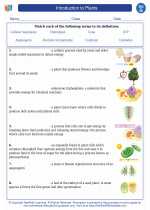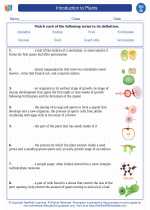Introduction to plants -> sexual reproduction
Sexual Reproduction
Sexual reproduction is the process by which offspring are produced by the combination of genetic material from two parent organisms. This process involves the fusion of male and female gametes, resulting in genetic diversity in the offspring.
Key Concepts:
1. Gametes: These are specialized reproductive cells, such as sperm in males and eggs in females, that unite during sexual reproduction to form a new organism.
2. Meiosis: Meiosis is the type of cell division that produces gametes. It involves two rounds of division, resulting in the formation of four haploid cells, each with half the number of chromosomes as the original cell.
3. Fertilization: Fertilization is the process by which a sperm cell fuses with an egg cell to form a zygote, which then develops into a new organism.
4. Genetic Diversity: Sexual reproduction leads to genetic variation in offspring due to the combination of genetic material from two parents, which helps in adaptation and survival of the species.
Study Guide:
- Define sexual reproduction and explain its significance in the life cycle of organisms.
- Describe the process of meiosis and its role in the formation of gametes.
- Explain the events that occur during fertilization and the formation of a zygote.
- Discuss the advantages of genetic diversity resulting from sexual reproduction.
- Compare and contrast sexual reproduction with asexual reproduction, highlighting their differences and advantages.
Understanding sexual reproduction is crucial in comprehending the diversity and evolution of life forms on Earth. It is also fundamental in understanding inheritance and genetics.
.◂Biology Worksheets and Study Guides High School. Introduction to plants

 Worksheet/Answer key
Worksheet/Answer key
 Worksheet/Answer key
Worksheet/Answer key
 Vocabulary/Answer key
Vocabulary/Answer key
 Vocabulary/Answer key
Vocabulary/Answer key
 Vocabulary/Answer key
Vocabulary/Answer key
 Vocabulary/Answer key
Vocabulary/Answer key
 Vocabulary/Answer key
Vocabulary/Answer key
